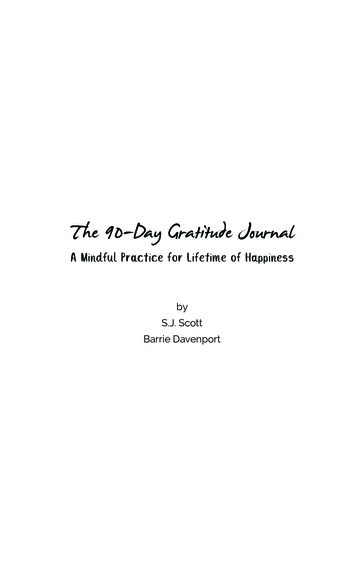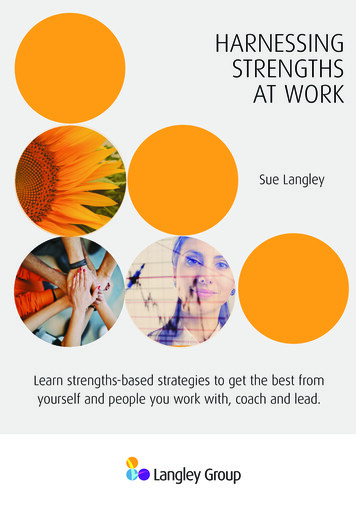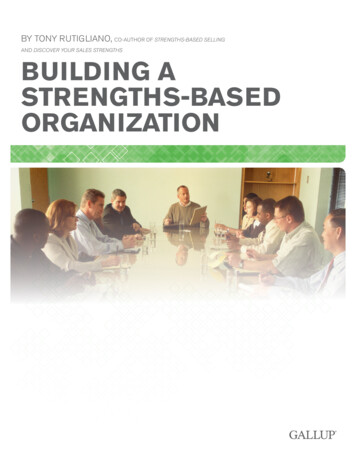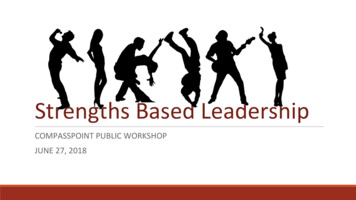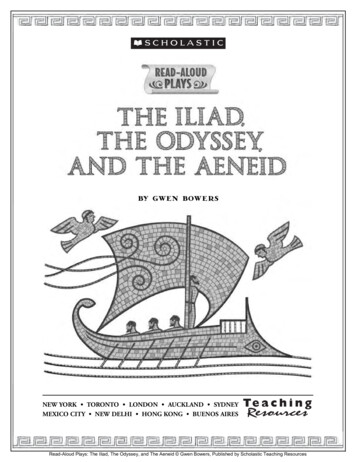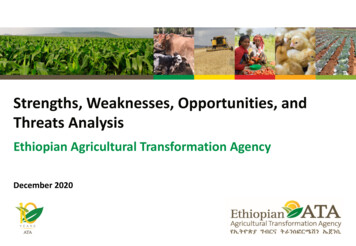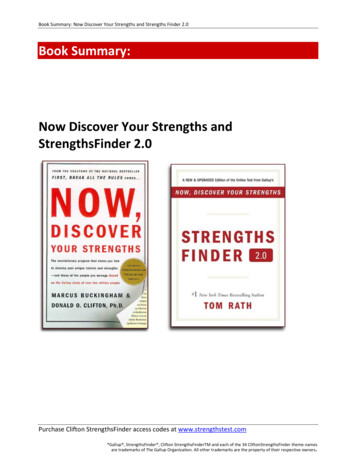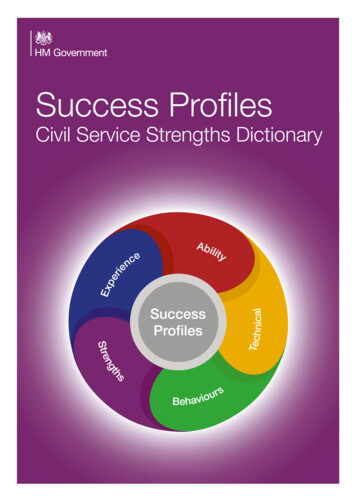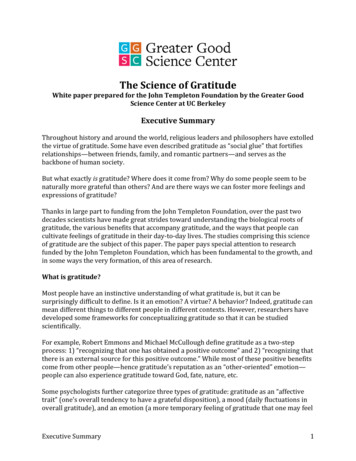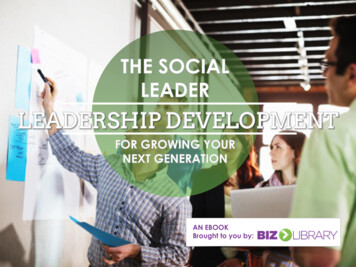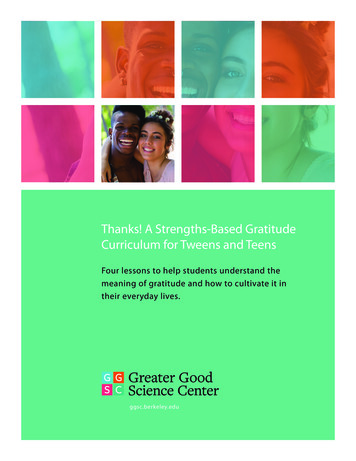
Transcription
Thanks! A Strengths-Based GratitudeCurriculum for Tweens and TeensFour lessons to help students understand themeaning of gratitude and how to cultivate it intheir everyday lives.ggsc.berkeley.edu
Thanks! A Strengths-Based GratitudeCurriculum for Tweens and TeensTable of ContentsIntroduction3Lesson 1: Discover Your Grateful Self10Lesson 2: See The Good Challenge17Gift of the Magi–ReadingGratitude Challenge–ActivityGratitude Journal–ActivityGood Week Reflection–ActivitySubtracting Good Things–ActivityLesson 3: Seeing The Good In Others35Go Out And Fill Buckets–ActivityLesson 4: Thank You For Believing In MeGratitude Letter243
Thanks! A Strengths-Based GratitudeCurriculum for Tweens and TeensIntroductionOver the past two decades, studies have consistently found thatpeople who practice gratitude report fewer symptoms of illness,including depression, more optimism and happiness, strongerrelationships, more generous behavior, and many other benefits.Further, research convincingly shows that, when compared with theirless grateful peers, grateful youth are happier and more satisfied withtheir lives, friends, family, neighborhood, and selves. They also reportmore hope, engagement with their hobbies, higher GPAs, and lessenvy, depression, and materialism.That’s why the Greater Good Science Center launched the YouthGratitude Project (YGP) as part of the broader Expanding the Scienceand Practice of Gratitude, a multiyear project funded by the JohnTempleton Foundation. In addition to advancing the knowledge ofhow to measure and develop gratitude in children, the YGP createdand tested a new gratitude curriculum for middle and high schoolers.The main idea of the YGP curriculum is that varied gratitudepractices should help students feel more socially competent andconnected, be more satisfied with school, have better mentalhealth and emotional well-being, and be more motivated aboutschool and their future. For example, practices like journaling thatgenuinely build on students’ strengths and guide them to have moremeaningful interactions and regular discussion with peers, teachers,and other adults.Preliminary evidence for the effects of the gratitude curriculumindicate that it is helping to decrease depression, anxiety, andantisocial behavior and increase hope, emotional regulation, andsearch for purpose.3
Thanks! A Strengths-Based GratitudeCurriculum for Tweens and TeensIntroductionIn describing the design of the gratitude curriculum, lead researcherDr. Giacomo Bono writes:Gratitude interventions for students should start byidentifying and engaging students’ character strengths andinterests, and they should let students appreciate the differentbenefits and benefactors in their lives for themselves. Let’s gobeyond lists and dry journals. When people “get” us and helpus through tough times, gratitude grows.Schools participating in the YGP curriculum have shared anecdotesabout students’ and parents’ enthusiasm for the gratitude lessons.Indeed, the character strength and gratitude exercises have not onlybeen affirmational—strengthening pride in students’ achievementsand building a sense of community—but, according to Dr. Bono, theyhave also been hijacking much of the wall space at Open Houses!We sincerely hope that, as students begin to practice gratitude,they will begin to see the value of altruistic choices and recognizethe good intentions of others, helping them to feel supported inreaching for the better.How To UseThe LessonsEach lesson follows a consistent format:Time Required: The time required is a suggested time based onfeedback from educators who have taught the lesson. For the fullbenefit, lessons should be taught in their entirety, which may takeone or two class periods.Grade Level: The lessons were designed for both middle and highschool students; however, teachers should feel free to adapt thelessons to meet the needs of their students.4Materials: The materials listed for each activity are deliberatelysimple and low-cost. An internet connection and a TV or projectorwill be required to show the videos. Links to PDFs of handouts andPowerPoint slides are included with the curriculum.
Thanks! A Strengths-Based GratitudeCurriculum for Tweens and TeensIntroductionHow To UseThe Lessons (cont’d)Learning Objectives: The learning objective describes the knowledge, skills, and/or attitudes that are developed in each activity.Social and Emotional Learning (SEL) Competencies: Social andEmotional Learning (SEL) is the process through which children learnand apply the knowledge, attitudes, and skills necessary to: Understand and manage emotionsSet and achieve positive goalsFeel and show empathy for othersEstablish and maintain positive relationshipsMake responsible decisionsFive social-emotional competencies have been identified bythe Collaborative for Academic, Social, and Emotional Learning(CASEL) as foundational. The table on the next page lists thosecompetencies, and ways in which gratitude practices can supporttheir development.5SEL CompetenciesHow Gratitude Practices SupportThis CompetencySelf-awareness: The ability toaccurately recognize one’s emotionsand thoughts and their influence onbehavior. This includes accuratelyassessing one’s strengths andlimitations and possessing a wellgrounded sense of confidence andoptimism.Students develop a deeper awarenessof their thoughts and feelings whenthey reflect mindfully on theirexperience of gratitude. Choosingto express gratitude also enhancesstudents’ confidence and optimism.Self-management: The ability toregulate one’s emotions, thoughts,and behaviors effectively in differentsituations. This includes managingstress, controlling impulses, motivatingoneself, and setting and workingtoward achieving personal andacademic goals.Choosing to respond with gratitude,when experiencing kindness fromothers, requires students to regulatetheir thoughts, feelings and actions.
Thanks! A Strengths-Based GratitudeCurriculum for Tweens and TeensIntroductionHow To UseThe Lessons (cont’d)SEL Competencies (cont’d)How Gratitude Practices SupportThis Competency (cont’d)Social awareness: The ability to takethe perspective of and empathizewith others from diverse backgroundsand cultures, to understand socialand ethical norms for behavior, andto recognize family, school, andcommunity resources and supports.By considering the intentions andefforts of those they are grateful to,students develop social awareness. Inparticular, they develop the ability totake the perspective of others and toempathize with them.Relationship skills: The ability toestablish and maintain healthy andrewarding relationships with diverseindividuals and groups. This includescommunicating clearly, listeningactively, cooperating, resistinginappropriate social pressure,negotiating conflict constructively,and seeking and offering help whenneeded.When they express gratitude, studentsestablish and maintain healthy relationships with others. Planning and carryingout acts of kindness toward others alsostrengthens relationship skills.Responsible decision making: Theability to make constructive andrespectful choices about personalbehavior and social interactions basedon consideration of ethical standards,safety concerns, social norms, therealistic evaluation of consequences ofvarious actions, and the well-being ofself and others.In choosing to express gratitude,students practice responsible decisionmaking and enhance the well-beingof others, themselves and the worldaround them.Getting Ready for This Activity: This section offers simple waysa teacher might explore the activity for themselves first beforeteaching it to students. Indeed, research suggests that teachers whoexhibit gratitude feel more satisfied, accomplished, and have moreemotional reserves. Experiencing the benefits of gratitude firsthandcan enhance your work with students by helping you be more intune with how they will engage with the activities in this guide.How to Do It: The process of each activity is described in detail. Thiscan be adapted to suit the needs of the group.6
Thanks! A Strengths-Based GratitudeCurriculum for Tweens and TeensIntroductionHow To UseThe Lessons (cont’d)Reflection After the Activity: To deepen the experience of theactivity, we suggest asking students to reflect on the impact of thisactivity on themselves.Key themes in the gratitude lessonsCentral to the concept of gratitude are the ideas of intention, benefit,and cost or “benefit appraisals”. According to gratitude researchersJeffrey Froh and Giacomo Bono: Acts of kindness that inspire gratitude are usually done on purpose,with intention. Someone has noticed us, thought about what weneed, and chosen to do something to meet that need. Reflecting onthe intentions behind these acts deepens our sense of gratitude. A related idea is that each act of kindness has a cost to theperson who performs it. The cost may include time, effort orsomething that was given up, as well as any financial cost. Whenwe understand those costs, we gain a deeper appreciation of theperson who acted in a caring way. Finally, others’ acts of kindness benefit us personally in waysthat may be material, emotional, and/or social. Noticing andacknowledging the ways we benefit from others’ actions enhancesour gratitude.Teaching gratitude in a culturally-responsive wayWhen teaching about gratitude in a school setting, it is important tokeep in mind that the school community is made up of adults andchildren who differ in terms of culture, race, socioeconomic status,and religious background. This may mean that they also differ in theway they express and practice gratitude.In some cultures, and contexts, verbal expressions of gratitude arecommon, while in others a gesture, a reciprocal act of kindness orcaring, a simple or elaborate ritual, or giving a small token or gift maybe seen as more appropriate. How gratitude is expressed to anothermight differ depending on how familiar one is with the other person.7
Thanks! A Strengths-Based GratitudeCurriculum for Tweens and TeensIntroductionHow To UseThe Lessons (cont’d)Gratitude may also be expressed differently to a peer, as opposedto someone with a different social status. Welcoming discussion ofthese and other differences in the classroom will deepen students’understanding of gratitude.In conversations about gratitude, it is essential to be mindful thatsome children may be living with significant challenges. These mayinclude illness, family stress, the loss of a loved one, abuse, neglect,exposure to violence, discrimination, and economic hardship.Children who receive adult support (from their home, school, orcommunity) in dealing with these challenges may have a heightenedsense of gratitude for all that is in their environment that enablesthem to cope. On the other hand, children with fewer supportsystems may find it difficult to identify life events they feel grateful for.Gratitude cannot be imposed from the outside. Suggesting thatchildren “look on the bright side” in the face of personal struggle,community suffering, and/or systemic inequities would be verydismissive. Researchers Jeffrey Froh and Giacomo Bono suggest thatan appropriate response to children for whom high levels of stressmakes the experience of gratitude challenging is to listen deeply,empathize, and acknowledge their feelings.An example might be to say, “That sounds really difficult I can seewhy you are feeling like it can be hard to think of something to begrateful for.” Allowing children to be seen and heard, even whenthey are distressed, lets them know that their feelings are valid. Byhelping them understand and express their emotions, teachers cancontribute to building children’s resilience, as well as their capacityto understand and acknowledge the feelings of others—which isessential to gratitude.Another consideration that may arise when exploring gratitude inthe classroom is the influence of materialism. In a society oriented toconsumerism, students may tend to focus on material things whenconsidering what they are grateful for. They may feel envious of thepossessions of others. Or they may take their possessions for granted,8
Thanks! A Strengths-Based GratitudeCurriculum for Tweens and TeensIntroductionHow To UseThe Lessons (cont’d)finding it difficult to value and appreciate what they do have.Introducing gratitude practices in the classroom can help diminishthe sense of entitlement with which some students approach life.Through becoming more mindful of how to express gratitude, orthrough doing acts of kindness for others, they can experience both“giving” and “receiving” in ways that have a deep emotional impact.This can heighten awareness of the many intangible sources of goodin our lives.For more gratitude activities for grades K-8, click here.ContributorsLesson Development and Refinement:Giacomo Bono and Yvonne HuffakerCalifornia State University, Dominguez HillsResearch Associated with Curriculum Development and Refinement:Giacomo BonoCalifornia State University, Dominguez HillsKendall Bronk, Susan Mangan, Rachel BaumsteigerClaremont Graduate UniversityAncillary Materials:- Teacher slides: Susan Mangan, Rachel Baumsteiger- Videos: Giacomo Bono, Rachel Baumsteiger, Susan Mangan- Exercises and activities: Yvonne Huffaker, Giacomo Bono,Rachel Baumsteiger, Susan ManganGiacomo Bono, the Youth Gratitude Project team, and the Greater Good ScienceCenter would like to thank the John Templeton Foundation for the generousgrant funding that made this educational resource, and the research it is basedon, possible. Special thanks also go out to the schools in Southern California whoengaged in the research, the teachers who participated in the initial focus groupsand the many educators who provided valuable feedback along the way.9
GRATITUDE AC TIVIT Y FOR T WEENS & TEENSLesson 1Discover Your Great Full SelfStudents identify their strengths to gain a better understanding of themselves.Time Required1 class periodGrade Level6th – 12th gradeMaterials Lesson One PowerPoint slideshow Computer and monitor or projector to show video Computer or other device for every student to take computerbased survey Poster paper (one per student), pencil, markers, colored pencils, etc. VIA Strengths PosterLearning ObjectivesStudents will: Identify their top five character strengths Gain a greater understanding of themselvesSEL Competencies Self-Awareness Identifying personal strengthsGetting ReadyFor This Activity10Educators:Take the adult version of the VIA to explore your own characterstrengths. Do you agree with the survey results of your top fivestrengths (i.e., your signature strengths)? Think of a moment in yourlife when you were performing at your best, and consider how any ofyour top strengths factored into that successful moment.
Lesson 1Discover Your Great Full SelfHow To Do ItSlide 1Introduce the LessonGratitude ActivityLesson 1Discover YourGreat Full SelfWe have a special opportunity to learn aboutgratitude, how to practice it and why, and to learnabout the gifts we each carry around inside us sothat we can use them to make the world better. Introduce this program and its purpose: These lessons give us a special opportunity to learn aboutgratitude, how to practice it and why, and to learn about thegifts we each carry around inside us so that we can use them tomake the world better.Slide 2Character StrengthsGratitude ActivityLesson 1Character Strengths11 Introduce character strengths:
Lesson 1Discover Your Great Full Self Before we get going on gratitude, we want to start thisprogram by talking about YOU. Specifically, what are someof your top strengths?Character strengths are personal qualities, like honesty andleadership, that help you get along in the world and be abetter person. People tend to be stronger at a few of thesevirtues than others. Knowing your character strengthsand using them can help you be happier and moresuccessful in the world. So Have students look at the word cloud on the slide and guesswhich would be their top three strengths.Slide 3Character StrengthsVideoGratitude ActivityLesson 1What Are Character Strengths?Watch this video tolearn more aboutCharacter Strengths,why they matter,and what they meanfor you! Have students watch the video “The Science of Character”(8 minutes).12
Lesson 1Discover Your Great Full SelfSlide 4Character StrengthsSurveyGratitude ActivityLesson 1Character StrengthsTake a Character Strength survey at this t/registerRecord your top5 strengths and abrief descriptionof each. After watching the video, tell students that they will now take anonline survey that will help them discover their own characterstrengths. Now it’s your turn to find about YOUR strengths! We’regoing to take a survey that will help you identify yourcharacter strengths. Everyone pull out a device and go to the following website(see slide). Under the heading, “Register to Get Started,” enter yourname, email, gender, date of birth, and a password. Makesure the second box (“I have read of this agreement”) ischecked, then click “register.” On the next page, select, “I want to take the VIA survey foryouth” (it’s shorter than the adult version), then click, “Takesurvey.” On the next page, select, “I am taking the survey for myself.”Answer all of the questions.13
Lesson 1Discover Your Great Full Self At the end of the survey, you will come to a page labeled“demographics.” You can fill in the information if you wish, oryou can just click, “Complete survey.” On the next page, click “Download your character strengthsprofile.” Teachers: If you haven’t yet taken the survey, please do so now! After everyone has completed the survey, tally up everyone’sstrengths (see the next slide).Slide 5Tallying Up theClass’s CharacterStrengthsGratitude ActivityLesson 1 Tally up the class’s strengths: Ask the students to look at their toptwo strengths. Then get a tally of how many students had one oftheir top two strengths in the wisdom category, courage category, etc. Then reveal what your class’s top strengths were, e.g., “Looks likeour class is really high on justice and courage!” This is a fun way foreveryone to get a sense of each other’s strengths.14
Lesson 1Discover Your Great Full SelfSlide 6How You Can UseYour StrengthsGratitude ActivityLesson 1Character StrengthsIn pairs, turn to a partner and share one way you could useeach of your top strengths to do something nice for someone. Students will now have an opportunity to discuss how they mightuse their strengths. Next I want you to get into partners and discuss how youcould each use one of your top strengths to help othersor society. For example, if one of your top strengths isbravery, then you might make a good firefighter. Or, ifyou score high in creativity, then you could use it tocreate music. If you score high in kindness, how might youfind opportunities to encourage others to be kind? Give students a few minutes to discuss their strengths with apartner. Hand out poster materials and have each student create a posterthat lists his or her top five character strengths. This can beas creative as they would like and could include art work thatsymbolizes their strengths. They could use pictures, images,drawings and words to describe themselves and their top fivestrengths. (OPTION: This can also be done as homework.) Teachers can create their own simpler poster that lists two of theirtop five strengths, one that may be apparent to most students andone that may not be.15
Lesson 1Discover Your Great Full SelfReflection AfterThe Activity Ask for a few volunteers to share an idea for how to use a particularstrength. Ask students to reflect either verbally or in written form aboutsomething that they discovered about themselves or thatsurprised them from this activity.16
GRATITUDE AC TIVIT Y FOR T WEENS & TEENSLesson 2See The Good ChallengeStudents discuss what gratitude means and why itis important.Time Required1 class periodGrade Level6th – 12th gradeMaterials Learning ObjectivesStudents will: Define gratitude and why it’s important Understand the costs of kindness and the benefits of receiving itSEL Competencies Social Awareness- Practicing empathy, including perspective taking Responsible Decision-Making- Understanding the motivations for actions and their realisticconsequencesGetting ReadyFor This Activity17Lesson 2 PowerPoint slideshowComputer and monitor or projector to show video(s)Gratitude Challenge and Journal handout for each studentOptional: Gift of the Magi handout for each student and Gift of theMagi discussion questions for the teacherEducators:Keep a gratitude journal for a week, recording twice a week at leastthree things or people for whom you are grateful. At least once,consider the cost to someone who did something for you and howhis or her action benefited you. How does keeping a gratitude journalmake you feel?
Lesson 2See The Good ChallengeHow To Do ItSlide 1Introduce theLessonGratitude ActivityLesson 2See The GoodChallengeLet’s learn what gratitude is and why itcan make us feel better. Introduce the lesson.- Today we’re going to talk about what gratitude is. Can anyonetell me what gratitude is?Slide 2Definition ofGratitudeGratitude ActivityLesson 2GratitudeGratitude The ability to recognize and acknowledgethe good things, people, and places in our lives. After several students offer their definitions of gratitude, offerthem this definition.18
Lesson 2See The Good ChallengeSlide 2Definition ofGratitude (cont’d)- Gratitude is the ability to recognize and acknowledge thegood things, people, and places in our lives.- For example, if your friend goes out of their way to do you afavor, you would probably feel grateful towards them.- Now I know you’ve heard of this before, but what you mightnot know is that it can have enormous implications for yourphysical and mental health.Slide 3Gratitude VideoGratitude ActivityLesson 2Gratitude Is Have students watch this video “Nature. Beauty. Gratitude”(9:47 minutes.) For a shorter version of the video, start at 3:31. Please note: In the longer version of the video, there is a briefmoment of nudity (:29 to :32).19
Lesson 2See The Good ChallengeSlide 4Why GratitudeIs GoodGratitude ActivityLesson 2Why Gratitude Is Good It feels good! Better physical health It makes relationshipsstronger It makes people feelhappier in the long-run After watching the videos, share with students what science hasdiscovered about why gratitude is good for us.- There have been many studies on the effects of gratitude,and they confirm a few main effects.- First, gratitude is a positive emotion, so it feels good to begrateful. Positive emotions like gratitude can also make youfeel more open, creative, and energized.- Second, feeling grateful has been linked to physical healthoutcomes such as lower blood pressure and strongerimmune system functioning.- Next, because gratitude involves recognizing other peoplefor their kindness, feeling and expressing gratitude can helpstrengthen relationships.- And, because of all these factors, people who feel and expressgratitude more often tend to feel happier overall.20
Lesson 2See The Good ChallengeSlide 5Gratitude WarmupGratitude ActivityLesson 2WarmupTurn to a partner andshare three things youare grateful for today. In pairs, have students take about one minute to list three thingsthey’re grateful for.- You can be grateful for big things, like having supportiveparents, or small things, like being able to say “hi” to your friendbefore class started. After a minute, ask for volunteers to share what they weregrateful for.- Gratitude seems pretty simple, right? Let’s take a closer look atwhat we might ask ourselves when we feel gratitude 21
Lesson 2See The Good ChallengeSlide 6When Should YouFeel Grateful?Gratitude ActivityLesson 2When Should You Feel Grateful? Someone helps you on purpose The help that person offers benefits you Helping you cost that person something- Costs can include time, money,effort, etc. Discuss with students the intention, cost, and benefit--or “benefitappraisals”--when someone does something kind for you.- First, did the person do it on purpose? There’s a big differencebetween someone doing something to help you for selfishreasons (like needing a favor later) versus for selfless reasons (likedeciding ahead of time to do something helpful just for you).- Second, did the person’s help benefit you? Think about it: Forsomeone to help you, he or she has to really think about whatyou need or want. You wouldn’t be super grateful if someonebrought you a tissue when you didn’t need one.- And finally, what did that act cost the other person? We oftenthink of costs in terms of money, but it also includes people’stime and effort. For instance, if your mom gives you a ride to themall, she not only spends money on gas, but also spends hertime, which she could use to do something more fun for her.- Altogether, we may feel particularly grateful towards someonewho sacrifices his or her own time, money, or effort to dosomething on purpose that benefits us.22- Now we’re going to watch a video to demonstrate what we’vebeen talking about.
Lesson 2See The Good ChallengeSlide 7When Should YouFeel Grateful?Gratitude ActivityLesson 2VideoSesame Street Video Image Needed Have students watch Sesame Street’s Gift of the Magi (9:25) ORread the story. After the video, discuss how it’s appropriate to feel gratefulto people when it COSTS them to give you something and it’sVALUABLE to you. Introduce the GRATITUDE CHALLENGE, letting them know thattheir homework for the week is to write in their gratitude journalsat least four times about specific people and things for which theyfeel grateful.- Watch this video to introduce the gratitude journal (2:24).- If there are students skeptical about gratitude journaling,watch this video (2:04).Reflection AfterThe Activity23Ask students to reflect either verbally or in written form aboutsomething that they discovered about gratitude or that surprisedthem from this lesson.
pGift Of The MagiT h e G i f t oByfO.tHenryhe MagiONE DOLLAR AND EIGHTY-SEVEN CENTS.That was all. She had put it aside, one cent and then another and thenanother, in her careful buying of meat and other food. Della countedit three times. One dollar and eighty-seven cents. And the next daywould be Christmas.There was nothing to do but fall on the bed and cry. So Della did it.While the lady of the home is slowly growing quieter, we canlook at the home. Furnished rooms at a cost of 8 a week. There is little more to say about it.In the hall below was a letter-box too small to hold a letter. Therewas an electric bell, but it could not make a sound. Also there was aname beside the door: “Mr. James Dillingham Young.”1PAGE 1 GIFT OF THE MAGI
Gift Of The MagiO .H e n r yWhen the name was placed there, Mr. James Dillingham Youngwas being paid 30 a week. Now, when he was being paid only 20 aweek, the name seemed too long and important. It should perhaps havebeen “Mr. James D. Young.” But when Mr. James Dillingham Youngentered the furnished rooms, his name became very short indeed. Mrs.James Dillingham Young put her arms warmly about him and calledhim “Jim.” You have already met her. She is Della.Della finished her crying and cleaned the marks of it from her face.She stood by the window and looked out with no interest. Tomorrowwould be Christmas Day, and she had only 1.87 with which to buyJim a gift. She had put aside as much as she could for months, with thisresult. Twenty dollars a week is not much. Everything had cost morethan she had expected. It always happened like that.Only 1.87 to buy a gift for Jim. Her Jim. She had had many happyhours planning something nice for him. Something nearly good enough.Something almost worth the honor of belonging to Jim.There was a looking-glass between the windows of the room. Perhaps you have seen the kind of looking-glass that is placed in 8 furnished rooms. It was very narrow. A person could see only a little ofhimself at a time. However, if he was very thin and moved very quickly,he might be able to get a good view of himself. Della, being quite thin,had mastered this art.Suddenly she turned from the window and stood before the glass.Her eyes were shining brightly, but her face had lost its color. Quicklyshe pulled down her hair and let it fall to its complete length.The James Dillingham Youngs were very proud of two things whichthey owned. One thing was Jim’s gold watch. It had once belonged tohis father. And, long ago, it had belonged to his father’s father. Theother thing was Della’s hair.If a queen had lived in the rooms near theirs, Della would havewashed and dried her hair where the queen could see it. Della knewher hair was more beautiful than any queen’s jewels and gifts.If a king had lived in the same house, with all his riches, Jim wouldhave looked at his watch every time they met. Jim knew that no king2PAGE 2 GIFT OF THE MAGI
Gift Of The MagiT h eG i f to ft h eM a g ihad anything so valuable.So now Della’s beautiful hair fell about her, shining like a fallingstream of brown water. It reached below her knee. It almost made itselfinto a dress for her.And then she put it up on her head again, nervously and quickly.Once she stopped for a moment and stood still while a tear or two randown her face.She put on her old brown coat. She put on her old brown hat.With the bright light still in her eyes, she moved quickly out the doorand down to the street.Where she stopped, the sign said: “Mrs. Sofronie. Hair Articlesof all Kinds.”Up to the second floor Della ran, and stopped to get her breath.Mrs. Sofronie, large, too white, cold-eyed, looked at her.“Will you buy my hair?” asked Della.“I buy hair,” said Mrs. Sofronie. “Take your hat off and let me lookat it.”Down fell
Gratitude Project (YGP) as part of the broader Expanding the Science and Practice of Gratitude, a multiyear project funded by the John Templeton Foundation. In addition to advancing the knowledge of how to measure and develop gratitude in children, the YGP created and tested a new gra
